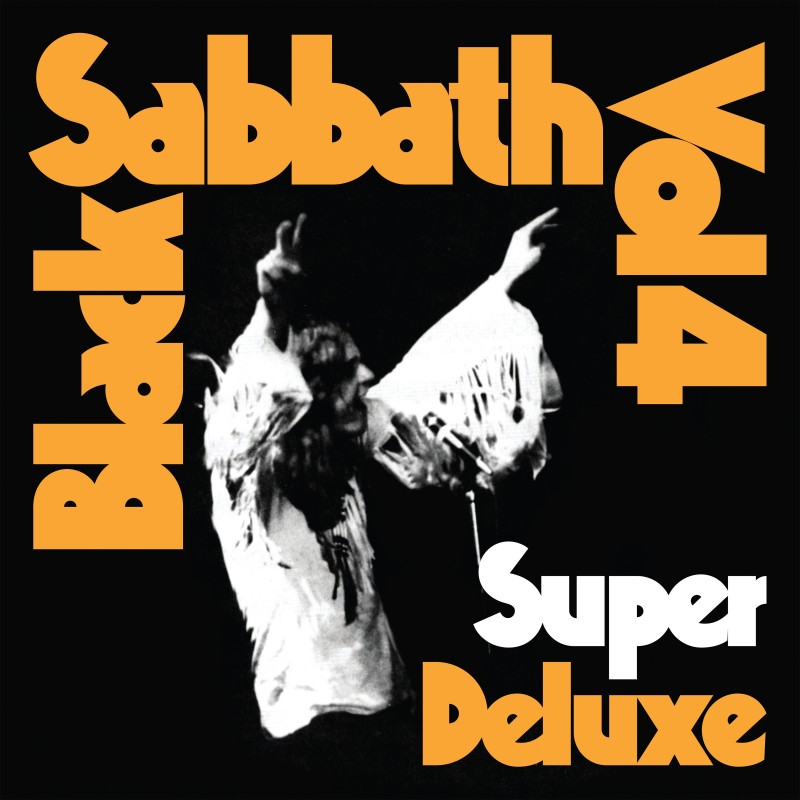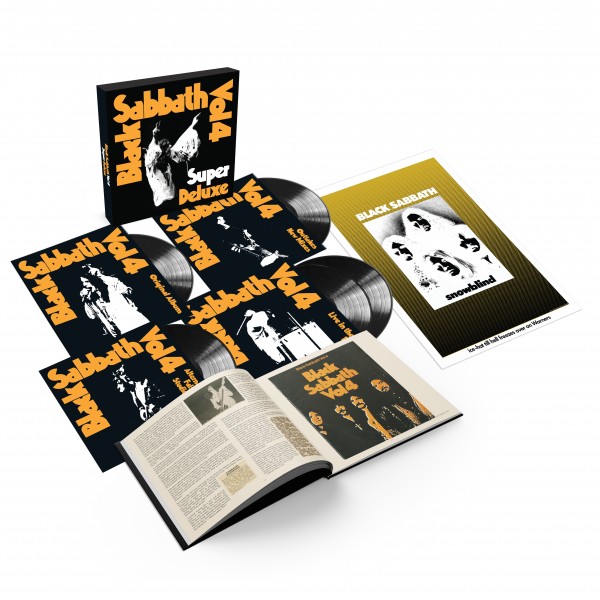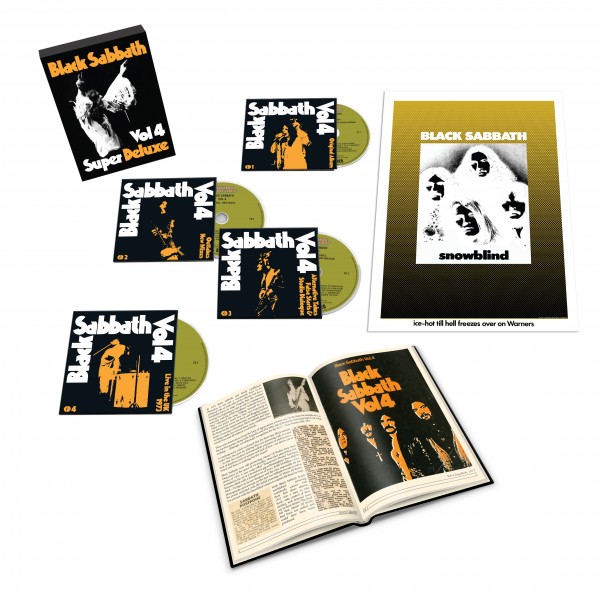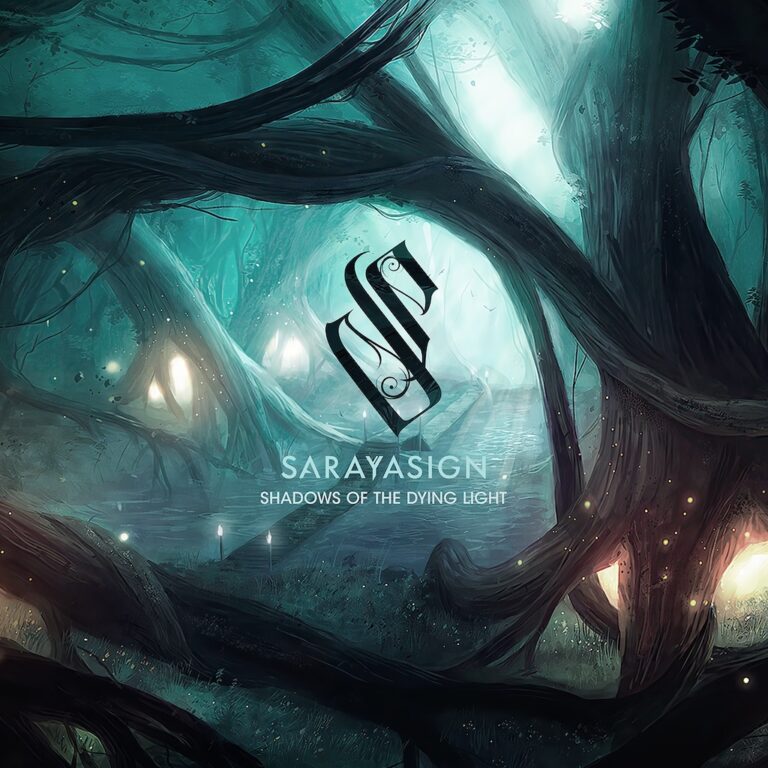
Introduction
Despite a certain critical acclaim (mirrored in the admiration of such high-profile artists as Thomas Gabriel Fischer and John Bonham), Vol 4 never received the attention it deserved from the band. When the Black Sabbath catalogue was reissued in 2009, the post-Master Of Reality Ozzy years were given scant attention compared to the double-disc sets issued in support of other albums within the band’s catalogue. Perhaps the tension that emerged in later years spoilt the band’s collective recollection and encouraged a certain reticence with regard these releases. Yet, if the stress of self-producing an album for the first time was compounded by the spiralling addiction issues that would eventually rip the band to pieces, that same tension (at least initially) served to heighten Sabbath’s faculties, resulting in one of their most devastatingly heavy, yet varied, albums to that point. As such, there’s an argument to be made that, of all the Sabbath albums, Vol 4 is the most deserving of the Super Deluxe treatment now being visited upon it.

The Package
Fortunately, BMG have form in curating box sets that offer real value to fans and this lavish entry is no exception. Available either as a 5 LP or 4 CD set, this Super Deluxe Edition allows fans an insight into the creative process behind a masterpiece and it exudes quality.
The LP edition (reviewed here) is housed in a sturdy box with lift-off lid. Printed in matte, with the track listing on the reverse, the box is a thing of beauty and there’s no mistaking the thrill that comes from removing the shrink wrap to experience the album anew.
Inside, you find the 5 LPs (three in heavy duty, tip-on sleeves; the final pair in a beautiful gatefold enclosure), a super-sized poster and, the icing on the cake, a hard backed book detailing the making of the album. The book, which is packed with fascinating insights collated by the ever-reliable Hugh Gilmour, and an array of period photos, is a particular delight and stands in contrast to the shiny, easily damaged texts that blighted the (similarly priced) Pink Floyd Immersion editions. There’s no other ephemera with which to contend, but the quality of the book and vinyl sleeves makes such trinkets redundant, and it is a genuine pleasure to ease the freshly-remastered album from its poly-lined sleeve and then sit back with the book as the needle hits the groove.
The Album – Remastering
Vol 4 stands as a powerful entry in the band’s catalogue and, if it is overshadowed by the first three albums, this says more about the exceptional quality of those records (and the sense of nostalgic awe in which they’re held) than it does about Vol 4. In a sense, the album sees Sabbath come of age, offering a diverse, mature set, whilst still maintaining the feeling of impending doom that hangs, like a pall, over the preceding efforts. The remastering, if we’re honest, is not massively revelatory but then, when it comes to classic albums, subtle evolution is often preferable to revolution and Vol 4 is no exception. Overall, the remaster (handled by Andy Pearce and Matt Wortham, who were also responsible for the 2009 remaster) feels less aggressive than its forebear, with the cymbals a touch crisper, the bass a little tighter and the overall volume a little lower, allowing for more dynamic across the board. It’s helped, too, by a flawless pressing that exudes not a single crackle but, on the whole, the effort seems to have been spent on cleaning the presentation up, rather than on attempting any sort of major sonic overhaul.
The Music
It starts, of course, with the monstrous Wheels Of Confusion, one of the band’s darkest moments and a truly epic eight minutes of peerless riffing. Wrong footing the listener with 20 seconds of pure blues, before peeling out the riff that launched a thousand doom bands, Sabbath sound utterly vital, exploring a range of influences from crushing metal to whigged-out psychedelia. With Tomorrow’s Dream, Sabbath play to the gallery with a heavy-riffing number that stands comfortably alongside anything from the first three albums and it is this sense of consistency that makes the mellotron-swept beauty of Changes such an unexpected and poignant gem in the band’s catalogue. Arguably, the track has lost some of its lustre over the years (not least thanks to the 2003 reworking) but, sat at the heart of side one, it sounds as fresh as ever. The somewhat pointless swirl of FX follows on the heels of Changes as if to reset the palette (although it still feels more like a band joke taken too far) before a truly monstrous Supernaut arrives like a juggernaut and brings the album’s first half to a sudden, brutal end.
Side two kicks off with the evergreen Snowblind, another fan favourite that plays to the band’s strengths. No less impressive, Cornucopia is pitch-black doom, the riff lumbering from the speakers with real weight. One of the album’s most savage cuts, it’s a perfect example of Sabbath’s monumental influence on metal, which makes the cinematic sweep of Laguna Sunrise, all the more of a contrast. A beautifully played, and beautiful, piece of music, it flows from the speakers, with the only slight disappointment being the band’s decision to fade the piece down rather than segue into the bluesy groove of St Vitus Dance. A cool track that can’t really compete with the opening pair of tracks, it serves mainly to prepare the ground for the hulking riffs and exceptional percussive barrages of Under The Influence / Every Day Comes And Goes, the album’s obsidian closer.
A svelte 43 minutes in length, Vol 4, may not be a perfect album, but its pacing, varied musical approach and abundance of classic cuts marks out as a special record, nonetheless, and this remaster is the best it has ever sounded.
New Mixes (LP 2)
Apparently indefatigable, Steven Wilson signed on to mix six outtakes from the original sessions. Returning to the multi-tracks, Steven coaxed remarkable depth and clarity out of the pieces, and the result is an alternate-reality version of the album that could just have easily existed, had the fates aligned differently.
The alternate Wheels Of Confusion / The Straightener has a bluesy energy that feels more jammed out than the final version, the rhythm section humming with power as Tony Iommi extracts molten riffs from his guitar. Perhaps not as well balanced as the original (the cymbals, in particular, feel a tad too bright), it’s a fascinating take bought majestically to life under Wilson’s supervision. Interestingly, Changes (in my view at least) improves on the original, the haunting chords of the mellotron and the rich tones of the piano offsetting a powerfully raw delivery from Ozzy. Wilson really draws out the vulnerability at the heart of the track, and this poignant rendering may well become my go-to version of the track from here on in. Of course, Sabbath rarely remain sentimental for long and, as the last notes drift away Supernaut comes crashing in with substantial force. The sequencing really works here and it’s clear that these new mixes were approached with the mindset that they would form an album in their own right, rather than a mere grab bag of extras.
The first side concludes with a crackling, raucous take on fan-favourite Snowblind. Tuning issues notwithstanding (the guitars sound unusually ropey in this regard), it’s a blistering take that does much to capture the ferocious energy of the band on stage and, although the final version may be the superior, this take has an energy all its own.
Laguna Sunrise opens side four and here we get our first taste of the studio dialogue that peppers the takes from here on in. It’s a worthy archival gem that sees the aimless strumming of Iommi suddenly snap into focus as the tape begins to roll, only to be just as suddenly halted by a terse command from the control room. Using the dialogue almost as a percussive device, Wilson drops us straight into the crushing proto-doom of Under The Sun (instrumental), a track that reminds you what a percussive force Bill Ward could be when given his head, the band whipping up one hell of a storm around him.
Studio Outtakes & Dialogue (LP2)
Beyond the six new mixes, Steven Wilson also lent his hand to eleven additional recordings which, in a similar vein to his exhaustive King Crimson projects, bring together false starts and studio chatter. Thus, rounding out LP 2, we get four versions of Wheels Of Confusion (charmingly named “bollocks” by a playful Ozzy). The first, a brief false start, is blink and you’ll miss it, while the remaining pieces (alternative takes 1,2,3) initially look like overkill. They do, however, highlight the evolutionary process the band adopted in order to hone their skills and, despite the fact that you’re hearing different versions of the same track, it never feels dull or overlong. For my money, it’s take 3 that really starts to hit the groove found in the final version; but all have their charms and it’s fascinating to hear the band feel their way towards the final take.
Studio Outtakes & Dialogue (LP 3)
Yet another take on Wheels Of Confusion opens up Side five yet, strangely, it feels fresh, the band attacking it with a vigour only hinted at on the previous versions. The Straightener follows (complete with snippet of studio chatter), the band giving a lively performance, although it rather collapses on itself at the conclusion. Snowblind, hilariously sees Ozzy pre-empting Beavis And Butthead as he sings the riff, but the take is incomplete, despite a powerful start. The side concludes with a blistering outtake of Supernaut and, if it finishes rather abruptly, it remains essential thanks to the sheer energy the band exude.
The first time the outtakes start to grate is on side six, which features a seemingly interminable array of false starts for Supernaut. Exhaustive in its detail, it’s the sort of thing that you might listen through once; but unlike LP 2, which is largely brilliant, this is of curio value only. However, by collecting the most obviously bitty selection of pieces on one side, it’s easily avoided, even if it is nice to hear Geezer playing the bassline to Zeppelin’s Dazed and Confused on the intro to Under The Sun (False Start). A rough version, with the bass clipping in the mix, it’s soon abandoned, and the side concludes with a full take complete with (hilariously wordless) guide vocals. Whilst listening to Ozzy “doo doo doo, da da da” through the track might not be something you’d choose to do on a regular basis, the raw firepower the band bring to bear is undeniable.

The Live Set (LPs 4 & 5)
Rather than opt for a straight live show, the final two discs of the set (housed in a beautiful, gatefold sleeve) offer a collection of tracks, seamlessly integrated in order to replicate a setlist from the era. Fortunately, the tracks are well-recorded, as they were always intended for official release (only to be ignominiously shelved), and they have been meticulously mixed from their original, 16-track source by Richard Digby Smith (the legendary chief engineer of Island’s UK studio division). This is a substantial bonus, filling in a rather sizable gap in collections and representing Sabbath sitting precariously at the peak of their success, unaware of the decline awaiting them on the other side.
From the moment the album explodes into life with Tomorrow’s Dream, there’s a tangible excitement to this live set that (for the most part) has no equal anywhere else in the Sabbath catalogue. As impressive as The End is as a document of the band’s final show, there was always a sense that nostalgia played as much of a part in the set as the performance, whereas here the band are a livid, living entity tearing up the stage with an abandon that, Wicked World aside, is almost punk in its ferocity. Just listen to the way Sabbath pummel Sweet Leaf into submission, whilst Ozzy’s interactions are an honest representation of his utter subservience to the performance, rather than the pantomime approach he adopted later. It all sounds huge and there’s a strong argument to be made that these discs house the definitive version of War Pigs, unleashed at roughly twice its recorded speed and underpinned by a rhythm section hell bent on destroying the foundations of the venue.
The unstoppable Snowblind kicks off the second side and it’s amazing to hear the band playing so iconic a track back when it was freshly minted (Ozzy ensuring the audience are onside with the none-too-subtle pun of the title) and if the band sound a touch hazy as they plunge headlong into Killing Yourself To Live, Cornucopia positively explodes from the speakers as the band revel in the heat of the lights (responsible for knocking the guitars out of tune) and the roar of the crowd.
Filling out a whole side, the gargantuan Wicked World takes in instrumental solos, bluesy jams and ad hoc digressions. In all honesty, it lacks the immediacy of the shorter tracks found elsewhere and, although it interpolates elements of Orchid, Into The Void and Sometimes I’m Happy, Iommi’s soloing is a little too rough and ready to really transport the home listener. However, the cheers of the crowd suggest that they were as caught up in the moment as the band, even if it does rather stretch the patience of the home listener.
The final side sees the band focused as they enter the home stretch. Supernaut is delivered with all the proficiency you’d expect after the multiple takes found on LP 4, Wicked World somewhat unbelievably returns for a reprise, before Embryo and an almighty Children Of The Grave bring us to the concert’s sweaty climax of Paranoid. Again, you can feel the palpable excitement of a crowd still coming to terms with the raw power of a band that was still very much on the ascent, and there’s an immediacy to the recording that is impossible to deny.
Final Thoughts
Unlike other entries in the Sabbath catalogue, Vol 4 has never received the attention it deserves. Thankfully, this monstrous set serves to redress the balance and the archivists have done a fantastic job of balancing the exhaustive requirements of a comprehensive set and the dictates of taste. Rather than stuff the box with ephemera, the money has been spent on curating a remarkable selection of pieces, all of which serve to further the story behind the album. Undoubtedly, one of the biggest coups was in bringing Steven Wilson on board. His deft touch transforms the six, newly-mixed outtakes into a mini-album that is as listenable as the original. The assorted outtakes and offcuts that follow, meanwhile, are varied enough to maintain the attention and different enough from the final versions to keep completists hooked with, perhaps, the exception of the Supernaut sessions found on side 6. Even then, the set is sequenced in such a way that the most obviously skippable pieces are in one place, so that you’re not left hunting through the grooves of a given side for a particular gem, and that sort of attention to detail is found right across the set. From the absolutely pristine, crackle-free vinyl to the heavy duty sleeves and the hard backed book, this is a collection that more than warrants a purchase and comes highly recommended. 9/10




